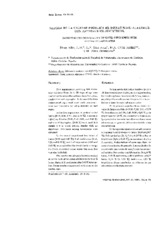Mejora de la calidad proteica de dietas maiz-altramuz con aminoácidos sintéticos
Improving protein quality of maize-lupin diets with synthetic aminoacids
Autor
Díaz Arca, J.F.
Pérez Alba, L.M.
Pérez Hernández, Manuel
Cejas Molina, M.A.
Editor
Universidad de Córdoba, Servicio de PublicacionesFecha
1990Materia
Pollos para carneAlimentación animal
Dieta
Eficacia proteica total (TPE)
METS:
Mostrar el registro METSPREMIS:
Mostrar el registro PREMISMetadatos
Mostrar el registro completo del ítemResumen
Two experiments involving 696 broiler type chickens from 14 to 28 days of age were carried out to assess the optimun level for lysine, methionine and tryptophan to be added to diets maize-sweet lupin seed meal made isonitrogenous and isocaloric by using soybean oil and sugar. In the first experiment, 4 levels of added lysine (0.16, 0.34, 0.52, and 0.70 %), 4 levels of added methionine (0.36, 0.46, 0.56, and 0.66 %) and one of triptophan (0.33 %) were used in a design 4 x 4. Good growth results with no significant differences among treatments were obtained. In the second experiment two levels of lysine (0.08 and 0.17 %), 3 of methionine (0.12, 0.24 and 0.36 %) and 2 of tryptophan (0.00 and 0.03 %) were added to the basal diet in a design 2 x 3 x 2. A control maize-white fish meal diet was also included. The results (weigth gain/protein intake) show the best amino acids addition to be 0.08 % lysine plus 0.12 % methionine plus 0.03 % tryptophan. These results compare well with those of the control diet. Se han usado 696 pollos broilers de 14 a 18 días de edad para hallar, en dos experiencias, los niveles óptimos de adición de lisina, metionina y,triptófano a dietas isonitrogenadas e isocalóricas a base de maíz-altramuz dulce. En la primera experiencia se usaron niveles de lisina añadida de 0,16, 0,30, 0,52 y 0,70 %; de metionina de 0,36, 0,46, 0,56 y 0,66 %, y de triptófano de 0,03 %, en un diseño 4 x 4 factorial. Los resultados de crecimiento fueron altos y no se observaron, en general, diferencias debidas a los tratamientos. En la segunda experiencia se adicionaron a la misma basal 2 niveles de lisina (0,08 y 0,017 %), 3 de metionina (0,12, 0,24 y 0,36 %) y dos de triptófano (0,00 y 0,03 %), en un diseño 2 x 3 x 2 factorial, incluyéndose además una dieta de control con harina de pescado. Los resultados de crecimiento (aumento de peso/consumo proteico) señalan los niveles más idóneos los de 0,08 % lisina, 0,12 % metionina, 0,00 triptófano, y 0,17 lisina, 0,12 % (0 0,24 %) metionina, 0,03 % triptófano. Estos resultados no difieren de los obtenidos con la dieta control.

